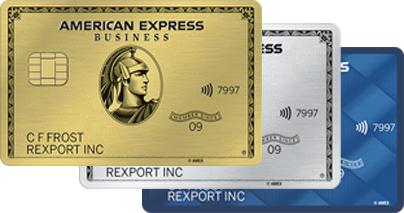
The Simple Guide to Opening a Business Checking Account
By Randi Gollin | American Express® Freelance Contributor
6 Min Read | October 11, 2021
Summary
No matter the size of your company, there are many compelling reasons why you should consider opening a business checking account. For starters, it keeps your personal finances separate from your business finances, making it easier to manage cash flow and day-to-day accounting – a boon come tax time.
But before hanging that “open for business” sign in the window or launching a social media marketing campaign, it’s important to get your business banking in order. Here are the five main steps required to open a small business checking account.

1. Choose the Right Type of Business Bank Account – Online or Brick-and-Mortar?
Before choosing a business checking account, it’s a good idea to determine whether you’ll be better served by a bank that’s strictly online or a brick-and-mortar bank with online services. Each has its pros and cons. Here’s how they may differ:
- Brick-and-mortar banks allow businesses to make cash deposits and withdrawals, write checks, and use a business debit card at the bank’s network of ATMs. Brick-and-mortar banks may also offer digital services, enabling businesses to transfer or receive money electronically, pay bills online, and make mobile phone deposits. On the flip side, traditional banks tend to offer lower interest rates than online banks and may have more fees.
- Online-only banks generally have higher interest rates and no fees or lower fees than traditional banks, but account owners may have to keep a monthly minimum balance to avoid fees or earn interest. Online banks can offer this because they don’t have the financial burden of a physical network. Online banks generally offer similar advantages to brick-and-mortar banks, but there’s no face-to-face contact with the bank. Instead, account owners can usually deposit checks through a mobile app – but not cash deposits or other cash transactions. Online banks may not have ATMs, and some may not offer checkbooks.
2. Find the Right Bank for Your Business Needs
Once you know whether you would like an online or traditional bank, it’s time to narrow down the options. Some things to consider are fees, accessibility, software integration, and additional financial product offerings – understanding each can help you get the most out of your business checking account.
- Fees: Some banks charge monthly maintenance fees of about $8-30 per month, but fees are often waived if the business keeps a minimum balance. There are other fees and limitations to look out for as well. For example, banks may charge wire transfer fees of $15-25 per transaction, limit transactions to 100 or 200 a month, impose fees for cash deposits over a set amount, or charge around $35 when the account has insufficient funds to cover a requested payment. Others may levy early termination fees if an account is closed before the required 60, 90, 180 days, or more.
- Accessibility: Consider how easy it is to do banking. Does the bank have 24/7 online banking and mobile apps that let you transfer money between accounts and deposit checks remotely? If choosing a brick-and-mortar bank, are there nearby branches and ATMs?
- Additional financial product offerings: If you’re planning to expand your business, it may be worth considering a bank that offers services like small business loans, business credit cards, and business lines of credit.
3. Learn What You Need to Open a Business Checking Account
Once a bank is chosen, the bank usually asks for your name and birthdate, a government-issued photo ID, proper documentation confirming the name and type of business and, oftentimes, a federal tax ID known as an Employer Identification Number (EIN) issued online by the IRS. Exact requirements generally depend on the business structure. For example:
Sole Proprietorships usually must provide:
- A Social Security number and two forms of personal ID, like a driver’s license, passport and/or Social Security card, instead of an EIN.
- A doing-business-as (DBA) certificate if your company name differs from your name.
Limited Liability Companies (LLC) usually must provide:
- An EIN.
- Articles of organization.
- Business organization documents, like a business partnership agreement and/or documents used to form the partnership.
- Additional documentation, such as business licenses and a signed declaration of unincorporated business.
Partnerships usually must provide:
- An EIN.
- Articles of organization.
- Business organization documents, such as the documents used to form the partnership and the business partnership agreement.
- Additional documentation, such as business licenses and a signed declaration of unincorporated business.
S Corporations (S-Corp) usually must provide:
- An EIN.
- Certified articles of incorporation.
- A corporate charter.
- A corporate resolution signed by the company’s officers and a signed signature card by account signers.
- Business licenses.
C Corporations (C-Corp) usually must provide:
- An EIN.
- Certified articles of incorporation.
- A corporate charter.
- A corporate resolution signed by the company’s officers and a signed signature card by account signers.
- Business licenses.
- Nonprofit requirements, such as a 501(c) letter from the IRS to establish tax-exempt status, if applicable.
4. Open Your Business Checking Account
Once the application is submitted, the bank reviews it. The approval process to open an online-only checking account can take as little as 10 minutes. Why so fast? Many online banks have lifted traditional banking restrictions, such as requiring an opening deposit to activate the account. The approval process at a brick-and-mortar bank may take anywhere from one to seven days, and initial deposit requirements can range from $20 to $1,500.
5. Deposit Funds into Your Account
When depositing funds, you may decide to make a cash deposit or transfer funds electronically between linked bank accounts. Or you might write a check to your business from your personal account, make an in-person deposit, or handle it remotely by scanning the check with your phone. Still, you may not gain instant access, since a federal law called the Expedited Funds Availability (EFA) lets banks put a hold on funds deposited into a new customer account. For accounts less than 30 days old, that may mean a hold on checks for up to nine days.

The Card your business deserves
From travel benefits to cash flow management, we've got a Card for you.






